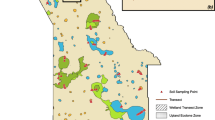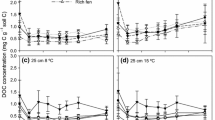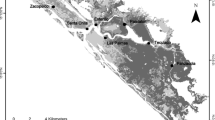Abstract
Wetlands play a vital role in terrestrial carbon (C) sequestration, but the sensitivity of their C stocks to disturbance remains uncertain, requiring enhanced understanding of the processes that govern C storage and removal. The unique conditions in wetlands from different hydrogeomorphic (HGM) classes likely regulate the cycling, storage and vulnerabilities of wetland soil C stocks. To determine how differences in hydrogeomorphic setting influence soil organic carbon (SOC) processing, we compared C content and composition between depressional and slope wetlands located in the Colorado Rocky Mountains. Isolated depressional wetlands were characterized by seasonally declining water tables, slow discharge, high clay content, and thick organic horizons. Slope wetlands received perennial groundwater inputs and had coarser soil textures and thinner organic horizons. Seasonal snowmelt inputs coupled with low hydrologic discharge and higher clay content in depressional wetlands were predicted to sustain anoxic conditions, leading to high SOC content and chemically reduced C compounds. Depressional wetland soils had higher SOC content at depth and higher porewater DOC concentrations compared to slope wetland soils. Solid-state 13C nuclear magnetic resonance spectroscopy demonstrated that aliphatic compounds were the dominant SOC component in depressional wetlands compared to aromatic C forms in the slope wetlands. The higher prevalence of aliphatic carbon in depressional wetland soils suggests that stored SOC is protected by anaerobic conditions to a greater extent than in the slope wetlands, and that this SOC may be more vulnerable to drying and oxic conditions associated with wetland drainage and climate change.






Similar content being viewed by others
References
Alexander RR, Troendle CA, Kaufmann MR et al (1985) The Fraser Experimental Forest, Colorado: Research program and published research 1937–1985. U.S. Department of Agriculture, Forest Service, Rocky Mountain Forest and Range Experiment Station, Fort Collins
Aller RC (1994) Bioturbation and remineralization of sedimentary organic matter: effects of redox oscillation. Chem Geol 114:331–345
Alstatt D, Miles RL (1983) Soil survey of Grand County area, Colorado. USDA Soil Conservation Service and Forest Service and Colorado Agriculture Experiment Station, U.S. Government Printing Office
Ameli AA, Creed IF (2017) Quantifying hydrologic connectivity of wetlands to surface water systems. Hydrol Earth Syst Sci 21:1791–1808. https://doi.org/10.5194/hess-21-1791-2017
Armstrong W (1979) Aeration in higher plants. In: Woodhouse HW (ed) Advances in botanical research. Academic Press, London, pp 225–332
Baldock JA, Oades JM, Nelson PN et al (1997) Assessing the extent of decomposition of natural organic materials using solid-state 13C NMR spectroscopy. Soil Res 35:1061–1084. https://doi.org/10.1071/s97004
Berg B, McClaugherty C (2014) Plant litter: decomposition, humus formation, carbon sequestration, 3rd edn. Springer, Berlin
Bernal B, Mitsch WJ (2008) A comparison of soil carbon pools and profiles in wetlands in Costa Rica and Ohio. Ecol Eng 34:311–323. https://doi.org/10.1016/j.ecoleng.2008.09.005
Bernal B, Mitsch WJ (2012) Comparing carbon sequestration in temperate freshwater wetland communities. Glob Chang Biol 18:1636–1647. https://doi.org/10.1111/j.1365-2486.2011.02619.x
Bernhardt ES, Blaszczak JR, Ficken CD et al (2017) Control points in ecosystems: moving beyond the hot spot hot moment concept. Ecosystems 20:665–682
Bidel LPR, Renault P, Pagès L, Rivière LM (2000) Mapping meristem respiration of Prunus persica (L.) Batsch seedlings: potential respiration of the meristems, O2 diffusional constraints and combined effects on root growth. J Exp Bot 51:755–768. https://doi.org/10.1093/jexbot/51.345.755
Boye K, Noël V, Tfaily MM et al (2017) Thermodynamically controlled preservation of organic carbon in floodplains. Nat Geosci 10:415–419. https://doi.org/10.1038/ngeo2940
Bronk Ramsey C, Scott EM, van der Plicht J (2013) Calibration for archaeological and environmental terrestrial samples in the time range 26–50 ka cal BP. Radiocarbon 55:2021–2027
Carsey K, Kittel G, Decker K et al (2003) Field guide to the wetland and riparian plant associations of Colorado. Colorado National Heritage Program, Colorado State University, Fort Collins
Chadde SW, Shelly JS, Bursik RJ et al (1998) Peatlands on National Forests of the Northern Rocky Mountains: ecology and conservation. U.S. Department of Agriculture, Forest Service, Rocky Mountain Research Station, Fort Collins, CO
Chimner RA, Cooper DJ, Parton WJ (2002) Modeling carbon accumulation in rocky mountain Fens. Wetlands 22:100–110. https://doi.org/10.1672/0277-5212(2002)022%5b0100:mcairm%5d2.0.co;2
Chimner RA, Lemly JM, Cooper DJ (2010) Mountain Fen distribution, types and restoration priorities, San Juan Mountains, Colorado, USA. Wetlands 30:763–771. https://doi.org/10.1007/s13157-010-0039-5
Cotrufo MF, Soong JL, Horton AJ et al (2015) Formation of soil organic matter via biochemical and physical pathways of litter mass loss. Nat Geosci 8:776–779. https://doi.org/10.1038/ngeo2520
Covington WW (1981) Changes in forest floor organic matter and nutrient content following clear cutting in Northern Hardwoods. Ecology 62:41–48. https://doi.org/10.2307/1936666
Covino T (2017) Hydrologic connectivity as a framework for understanding biogeochemical flux through watersheds and along fluvial networks. Geomorphology 277:133–144
Eusterhues K, Rumpel C, Kleber M, Kögel-Knabner I (2003) Stabilisation of soil organic matter by interactions with minerals as revealed by mineral dissolution and oxidative degradation. Org Geochem 34:1591–1600. https://doi.org/10.1016/j.orggeochem.2003.08.007
Fagerstedt K (1992) Development of aerenchyma in roots and rhizomes of Carex rostrata (Cyperaceae). Nord J Bot 12:115–120
Fierer N, Schimel JP (2002) Effects of drying–rewetting frequency on soil carbon and nitrogen transformations. Soil Biol Biochem 34:777–787. https://doi.org/10.1016/S0038-0717(02)00007-X
Fifield LK (1999) Accelerator mass spectrometry and its applications. Rep Prog Phys 62:1223–1274
Fimmen RL, de Richter D, Vasudevan D et al (2008) Rhizogenic Fe–C redox cycling: a hypothetical biogeochemical mechanism that drives crustal weathering in upland soils. Biogeochemistry 87:127–141. https://doi.org/10.1007/s10533-007-9172-5
Fissore C, Giardina CP, Kolka RK, Trettin CC (2009) Soil organic carbon quality in forested mineral wetlands at different mean annual temperature. Soil Biol Biochem 41:458–466. https://doi.org/10.1016/j.soilbio.2008.11.004
Gavlak R, Hornek R, Miller RO, Kotuby-Amacher J (2003) Soil, plant and water reference methods for the western region. WREP-125
Grover SPP, Baldock JA (2010) Carbon decomposition processes in a peat from the Australian Alps. Eur J Soil Sci 61:217–230. https://doi.org/10.1111/j.1365-2389.2009.01220.x
Grover SPP, Baldock JA (2013) The link between peat hydrology and decomposition: beyond von post. J Hydrol 479:130–138. https://doi.org/10.1016/j.jhydrol.2012.11.049
Heller C, Ellerbrock RH, Roßkopf N et al (2015) Soil organic matter characterization of temperate peatland soil with FTIR-spectroscopy: effects of mire type and drainage intensity. Eur J Soil Sci 66:847–858. https://doi.org/10.1111/ejss.12279
Hilasvuori E, Akujärvi A, Fritze H et al (2013) Temperature sensitivity of decomposition in a peat profile. Soil Biol Biochem 67:47–54. https://doi.org/10.1016/j.soilbio.2013.08.009
Johnston BC, Stratton BT, Young WR et al (2012) Inventory of Fens in a Large Landscape of West-Central Colorado: Grand Mesa, Uncompahgre, and Gunnison National Forests. U.S. Forest Service, Delta
Jokic A, Cutler JN, Ponomarenko E et al (2003) Organic carbon and sulphur compounds in wetland soils: insights on structure and transformation processes using K-edge XANES and NMR spectroscopy. Geochim Cosmochim Acta 67:2585–2597. https://doi.org/10.1016/S0016-7037(03)00101-7
Kaiser K, Guggenberger G (2000) The role of DOM sorption to mineral surfaces in the preservation of organic matter in soils. Org Geochem 31:711–725. https://doi.org/10.1016/S0146-6380(00)00046-2
Kaiser K, Kalbitz K (2012) Cycling downwards-dissolved organic matter in soils. Soil Biol Biochem 52:29–32. https://doi.org/10.1016/j.soilbio.2012.04.002
Keiluweit M, Bougoure JJ, Nico PS et al (2015a) Mineral protection of soil carbon counteracted by root exudates. Nat Clim Chang 5:588–595. https://doi.org/10.1038/nclimate2580
Keiluweit M, Nico P, Harmon ME et al (2015b) Long-term litter decomposition controlled by manganese redox cycling. Proc Natl Acad Sci USA 112:E5253–E5260. https://doi.org/10.1073/pnas.1508945112
Keiluweit M, Nico PS, Kleber M, Fendorf S (2016) Are oxygen limitations under recognized regulators of organic carbon turnover in upland soils? Biogeochemistry 127:157–171. https://doi.org/10.1007/s10533-015-0180-6
Keiluweit M, Wanzek T, Kleber M et al (2017) Anaerobic microsites have an unaccounted role in soil carbon stabilization. Nat Commun 8:1771. https://doi.org/10.1038/s41467-017-01406-6
Keiluweit M, Gee K, Denney A, Fendorf S (2018) Anoxic microsites in upland soils dominantly controlled by clay content. Soil Biol Biochem 118:42–50. https://doi.org/10.1016/j.soilbio.2017.12.002
Kellogg KS, Shroba RR, Bryant B, Premo WR (2008) Geologic Map of the Denver West 30′ × 60′ Quadrangle, North-Central Colorado
Kleber M, Mikutta R, Torn MS, Jahn R (2005) Poorly crystalline mineral phases protect organic matter in acid subsoil horizons. Eur J Soil Sci 56:717–725
Knicker H (2011) Solid state CPMAS 13C and 15 N NMR spectroscopy in organic geochemistry and how spin dynamics can either aggravate or improve spectra interpretation. Org Geochem 42:867–890. https://doi.org/10.1016/j.orggeochem.2011.06.019
Knicker H, Ludemann HD (1995) 15 N and 13 C CP-MAS and solution NMR-studies of 15 N enriched plant material during 600 days of microbial degradation. Org Geochem 23:329–341
Kögel-Knabner I (1997) 13C and 15 N NMR spectroscopy as a tool in soil organic matter studies. Geoderma 80:243–270. https://doi.org/10.1016/S0016-7061(97)00055-4
Kögel-Knabner I, Amelung W, Cao Z et al (2010) Biogeochemistry of paddy soils. Geoderma 157:1–14. https://doi.org/10.1016/j.geoderma.2010.03.009
Kolka R, Trettin C, Tang W et al (2018) Chapter 13: Terrestrial wetlands. In: Cavallaro N, Shrestha G, Birdsey R et al (eds) Second State of the Carbon Cycle Report (SOCCR47): a sustained assessment report, USA. U.S. Global Change Research Program, Washington, D.C., pp 507–567
Lal R (2008) Carbon sequestration. Philos Trans R Soc Lond B Biol Sci 363:815–830. https://doi.org/10.1098/rstb.2007.2185
Lalonde K, Mucci A, Ouellet A, Gelinas Y (2012) Preservation of organic matter in sediments promoted by iron. Nature 483:198–200. https://doi.org/10.1038/nature10855
LaPerriere Nelson M, Rhoades CC, Dwire KA (2011) Influence of bedrock geology on water chemistry of slope wetlands and headwater streams in the southern rocky mountains. Wetlands 31:251–261. https://doi.org/10.1007/s13157-011-0157-8
Leifeld J, Steffens M, Galego-Sala A (2012) Sensitivity of peatland carbon loss to organic matter quality. Geophys Res Lett 39:L14704
Leinemann T, Preusser S, Mikutta R et al (2018) Multiple exchange processes on mineral surfaces control the transport of dissolved organic matter through soil profiles. Soil Biol Biochem 118:79–90. https://doi.org/10.1016/j.soilbio.2017.12.006
Lorenz K, Lal R, Preston CM, Nierop KGJ (2007) Strengthening the soil organic carbon pool by increasing contributions from recalcitrant aliphatic bio(macro)molecules. Geoderma 142:1–10. https://doi.org/10.1016/j.geoderma.2007.07.013
Luan J, Cui L, Xiang C et al (2014) Soil carbon stocks and quality across intact and degraded alpine wetlands in Zoige, east Qinghai–Tibet Plateau. Wetl Ecol Manag 22:427–438. https://doi.org/10.1007/s11273-014-9344-8
Marton JM, Creed IF, Lewis DB, Lane CR, Basu NB, Cohen MJ, Craft CB (2015) Geographically isolated wetlands are important biogeochemical reactors on the landscape. BioScience 65:408–418
McKee GA, Soong JL, Caldéron F et al (2016) An integrated spectroscopic and wet chemical approach to investigate grass litter decomposition chemistry. Biogeochemistry 128:107–123. https://doi.org/10.1007/s10533-016-0197-5
Meixner T, Manning AH, Stonestrom DA et al (2016) Implications of projected climate change for groundwater recharge in the western United States. J Hydrol 534:124–138
Mitsch WJ, Gosselink JG (2007) Wetlands, 4th edn. Wiley, Hoboken
Nierop KGJ (1998) Origin of aliphatic compounds in a forest soil. Org Geochem 29:1009–1016. https://doi.org/10.1016/S0146-6380(98)00165-X
Noël V, Boye K, Kukkadapu RK et al (2017) Understanding controls on redox processes in floodplain sediments of the Upper Colorado River Basin. Sci Total Environ 603–604:663–675. https://doi.org/10.1016/j.scitotenv.2017.01.109
NRCS (2008) Hydrogeomorphic wetland classification system: an overview and modification to better meet the needs of the natural resources conservation service. Technical note no. 190-8-76
Oades JM (1988) The retention of organic matter in soils. Biogeochemistry 5:35–70. https://doi.org/10.1007/BF02180317
Pett-Ridge J, Firestone MK (2005) Redox fluctuation structures microbial communities in a wet tropical soil. Appl Environ Microbiol 71:6998–7007. https://doi.org/10.1128/AEM.71.11.6998-7007.2005
Quideau SA, Anderson MA, Graham RC et al (2000) Soil organic matter processes: characterization by 13C NMR and 14C measurements. For Ecol Manag 138:19–27. https://doi.org/10.1016/S0378-1127(00)00409-6
Quideau SA, Chadwick OA, Benesi A et al (2001) A direct link between forest vegetation type and soil organic matter composition. Geoderma 104:41–60. https://doi.org/10.1016/S0016-7061(01)00055-6
R Core Team (2018) R: a language and environment for statistical computing. R Foundation for statistical computing, Vienna
Rasmussen C, Heckman K, Wieder WR et al (2018) Beyond clay: towards an improved set of variables for predicting soil organic matter content. Biogeochemistry. https://doi.org/10.1007/s10533-018-0424-3
Reimer PJ, Bard E, Bayliss A et al (2013) IntCal13 and Marine13 radiocarbon age calibration curves 0–50,000 years cal BP. Radiocarbon 55:1869–1887. https://doi.org/10.2458/azu_js_rc.55.16947
Retzer JL (1962) Soil survey of Fraser Alpine area, Colorado. U.S. Department of Agriculture, Washington, D.C.
Rezanezhad F, Couture R-M, Kovac R et al (2014) Water table fluctuations and soil biogeochemistry: an experimental approach using an automated soil column system. J Hydrol 509:245–256. https://doi.org/10.1016/j.jhydrol.2013.11.036
Rosenbloom NA, Doney SC, Schimel DS (2001) Geomorphic evolution of soil texture and organic matter in eroding landscapes. Glob Biogeochem Cycles 15:365–381. https://doi.org/10.1029/1999GB001251
Rumpel C, Kögel-Knabner I, Bruhn F (2002) Vertical distribution, age, and chemical composition of organic carbon in two forest soils of different pedogenesis. Org Geochem 33:1131–1142. https://doi.org/10.1016/S0146-6380(02)00088-8
Schimel DS, Braswell BH, Holland EA et al (1994) Climatic, edaphic, and biotic controls over storage and turnover of carbon in soils. Glob Biogeochem Cycles 8:279–293. https://doi.org/10.1029/94GB00993
Segnini A, Posadas A, Quiroz R et al (2010) Spectroscopic assessment of soil organic matter in wetlands from the high Andes. Soil Sci Soc Am J 74:2246–2253. https://doi.org/10.2136/sssaj2009.0445
Segnini A, Souza D, Alves A et al (2013) Characterization of peatland soils from the high Andes through 13 C nuclear magnetic resonance spectroscopy. Soil Sci Soc Am J 77:673–679. https://doi.org/10.2136/sssaj2012.0291
Simpson MJ, Otto A, Feng X (2008) Comparison of solid-state carbon-13 nuclear magnetic resonance and organic matter biomarkers for assessing soil organic matter degradation. Soil Sci Soc Am J 72:268–276. https://doi.org/10.2136/sssaj2007.0045
Soil Survey Staff (1999) Differentiae for mineral and organic soils. In: Soil taxonomy: a basic system of soil classification for making and interpreting soil surveys, 2nd edition. U.S. Department of Agriculture Natural Resources Conservation Service, pp 19–20
Sollins P, Kramer MG, Swanston C et al (2009) Sequential density fractionation across soils of contrasting mineralogy: evidence for both microbial- and mineral-controlled soil organic matter stabilization. Biogeochemistry 96:209–231. https://doi.org/10.1007/s10533-009-9359-z
Sposito G, Skipper NT, Sutton R et al (1999) Surface geochemistry of the clay minerals. Proc Natl Acad Sci USA 96:3358–3364. https://doi.org/10.1073/pnas.96.7.3358
Talma AS, Vogel JC (1993) A simplified approach to calibrating 14C dates. Radiocarbon 35:317–322
Taylor AFS, Fransson PM, Högberg P et al (2003) Species level patterns in 13C and 15 N abundance of ectomycorrhizal and saprotrophic fungal sporocarps. New Phytol 159:757–774. https://doi.org/10.1046/j.1469-8137.2003.00838.x
Tfaily MM, Cooper WT, Kostka JE et al (2014) Organic matter transformation in the peat column at Marcell Experimental Forest: humification and vertical stratification. J Geophys Res Biogeosci 119:661–675. https://doi.org/10.1002/2013JG002492
Torn MS, Trumbore SE, Chadwick OA et al (1997) Mineral control of soil organic carbon storage and turnover. Nature 389:170–173. https://doi.org/10.1038/38260
Ussiri DAN, Johnson CE (2003) Characterization of organic matter in a northern hardwood forest soil by 13C NMR spectroscopy and chemical methods. Geoderma 111:123–149. https://doi.org/10.1016/S0016-7061(02)00257-4
Wilson RM, Hopple AM, Tfaily MM et al (2016) Stability of peatland carbon to rising temperatures. Nat Commun 7:13723. https://doi.org/10.1038/ncomms13723
Wolf EC, Cooper DJ (2015) Fens of the Sierra Nevada, California, USA: patterns of distribution and vegetation. Mires Peat 15:1–22
Acknowledgements
We would like to thank Dr. Tom Wietsma for the access to the TOC analyzer, Ryan Taylor for his contribution to bulk soil analyses, Kelsey Dean for extensive field work, and Dr. Daniel Scott for assistance with carbon age calibrations, statistical analyses, and mapping. Funding was provided by USDA NIFA AFRI postdoctoral fellowship no. 2012-01330, and the Agriculture and Food Research Initiative Competitive Grant no. 2013-67019-21359 from the USDA National Institute of Food and Agriculture. A portion of the research was performed using EMSL, a DOE Office of Science User Facility sponsored by the Office of Biological and Environmental Research and located at Pacific Northwest National Laboratory.
Author information
Authors and Affiliations
Corresponding authors
Additional information
Responsible Editor: Breck Bowden.
Publisher's Note
Springer Nature remains neutral with regard to jurisdictional claims in published maps and institutional affiliations.
Electronic supplementary material
Below is the link to the electronic supplementary material.
Rights and permissions
About this article
Cite this article
Daugherty, E.E., McKee, G.A., Bergstrom, R. et al. Hydrogeomorphic controls on soil carbon composition in two classes of subalpine wetlands. Biogeochemistry 145, 161–175 (2019). https://doi.org/10.1007/s10533-019-00597-y
Received:
Accepted:
Published:
Issue Date:
DOI: https://doi.org/10.1007/s10533-019-00597-y




